READY TO GET STARTED?
REQUEST A FREE ESTIMATE
Fill out the form below or call (888) 466-7849 for a free, no-obligation estimate.
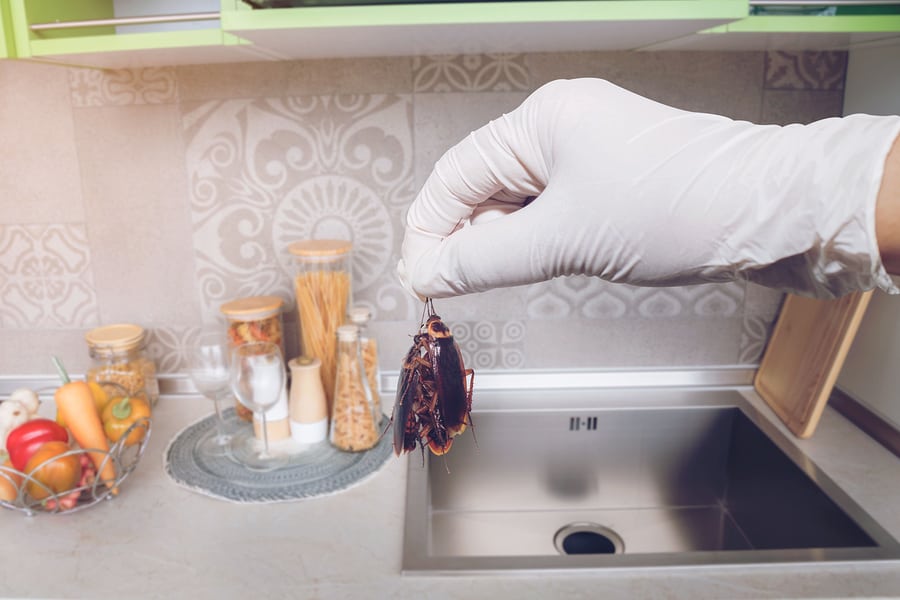
Did you know that an initial pest control inspection and treatment is just the beginning of your journey to a pest-free home? What comes next depends on the communication and joint efforts between your exterminator and you. This partnership is essential in your journey to staying worry-free and keeping your home free of any unwanted pests.
One of the actions your pest control professional will take is to make a list of environment modifications that will work in tandem with treatments performed in and around your home. Here’s a few examples of the steps they may outline to take your pest control further:
These simple tasks may seem insignificant but, in reality, they could be the difference between being pest-free and having an infestation. Should you have any lingering concerns, reach out to your local pest company, and they can work with you to adjust your Integrated Pest Management plan.
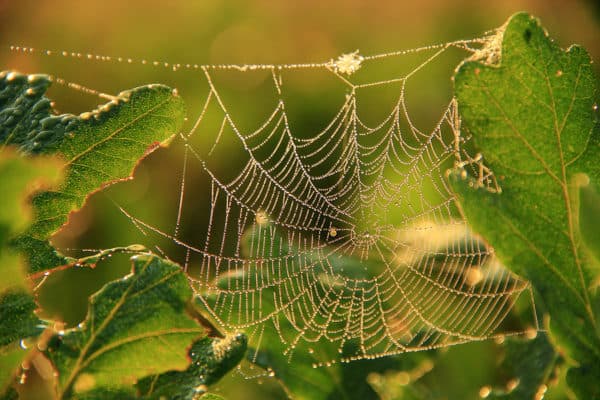
One of the most common questions that arises when a spider is found in a home is “is that spider poisonous?” That’s a trick question. Most spiders are poisonous, yet only a handful are venomous. Poisonous spiders release their toxins when they are inhaled, ingested or absorbed through the tissue or skin; in other words, they’re only harmful if you eat them. Venomous spiders, on the other hand, inject their toxin with a fang-like apparatus known as a chelicerae. These are the spiders you should be worried about and avoid contact with.
While there are more than 20 species of spiders in Georgia, there are only 2 that are known to be dangerous to humans: the black widow and the brown recluse. Like most common spiders, biting humans is a last line of defense. They are more likely to flee, hide, or even play dead rather than bite a human. It takes a long time for a spider to replenish his supply of venom after he injects it. Most will only use this defense mechanism if they have no other choice. Wasting venom on a human can even cause the spider to starve to death before his supply is replenished as he will have no means to kill any prey he catches.
Let’s take a closer look at each of the venomous spider species in Georgia, as well as some general tips to prevent spiders from getting into your home.
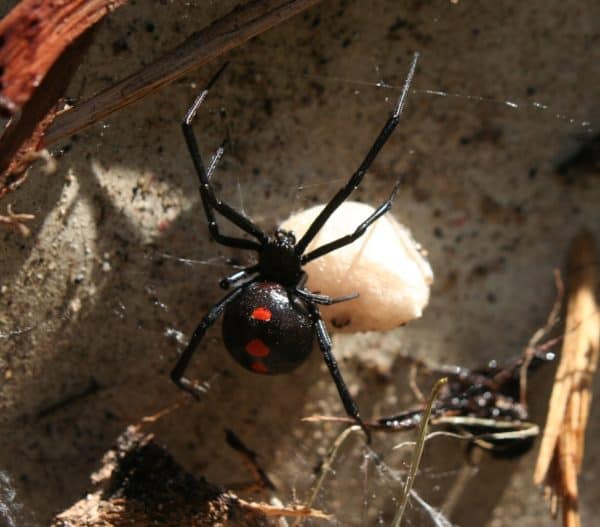
The black widow spider is considered to be the most venomous spider in North America. It is only the female black widow, however, that is dangerous to humans. Black widows are a red and black spider that is usually about 1.5 inches long with a shiny, globular abdomen and a reddish hourglass shape on its underside. While they are mostly black in color, they can sometimes be brown. The venom of a black widow spider is reportedly 15 times stronger than that of a rattlesnake. While black widow bites can be fatal to the young, the elderly, and those with compromised immune systems, most victims suffer no serious or long term damage from the bite. Black widows are not aggressive and bites commonly occur as a result of accidental contact. Common symptoms from a black widow bite include redness, swelling and tenderness at the site of the bite, muscle aches, nausea, and sometimes paralysis of the diaphragm which can cause difficulty breathing.
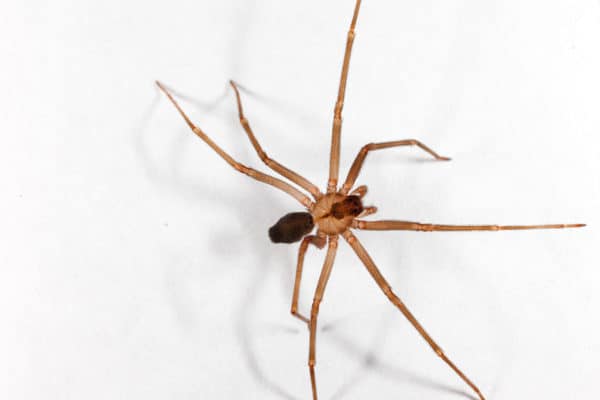
The brown recluse spider is also known as the violin spider or the fiddleback spider. The brown recluse is a light brown spider with a dark, violin-shaped marking on its back with the neck of the violin pointing toward the rear of the spider. They also have a very distinctive eye pattern with a semi-circular arrangement of 6 eyes (3 sets of 2) while most spider species have 8 eyes. Adult brown recluses are about the size of a quarter. They usually live outdoors under rocks, woodpiles, logs, etc. but are also well adapted to living indoors with humans. Once inside they are commonly found in attics, garages, basements, and are even known to wander into shoes, clothing, and bedding. They hunt at night and retreat to dark, secluded places in the daytime. The brown recluse is typically not aggressive and usually only bite when they are inadvertently trapped against human skin (rolling over on them in the bed or slipping your foot into a shoe they have crawled into for hiding). While bites are rare they can cause serious wounds and infections. The majority of bites remain localized, becoming red, swollen and tender at the site of the bite. If left untreated, a necrotic lesion may develop, usually accompanied by a central blister.
Keep your garages, attics, sheds, basements, and other areas that aren’t utilized often clean and clear of clutter. Try to avoid leaving clothing and shoes on the floor and store them in plastic bins if possible. Shake out any clothing that has been left on the floor or in a hamper before wearing or washing.
Seal any cracks and crevices around your home. Spiders can get in through damaged window screens or cracks in your siding. Inspect the outside of your home seasonally and make any repairs necessary.
Inspect any items that are brought from outdoors into your home. This includes any packages delivered to your porch or steps, groceries that may be placed on the driveway or porch as you are unloading, boxes of decorations being brought in from storage, or used appliances that are bought secondhand.
Contact a licensed pest control company if you suspect you have a spider problem. A professional pest control technician can inspect the exterior and interior of your home to help identify any possible entry points, identify the type of spiders and other pests you may be having issues with, and properly, safely, and effectively treat any pest problems they may encounter.
Request a Free Estimate to Get Started.
Avoid Bites and Stings This Summer
The Summer Big Three: Roaches, Mosquitoes, & Termites
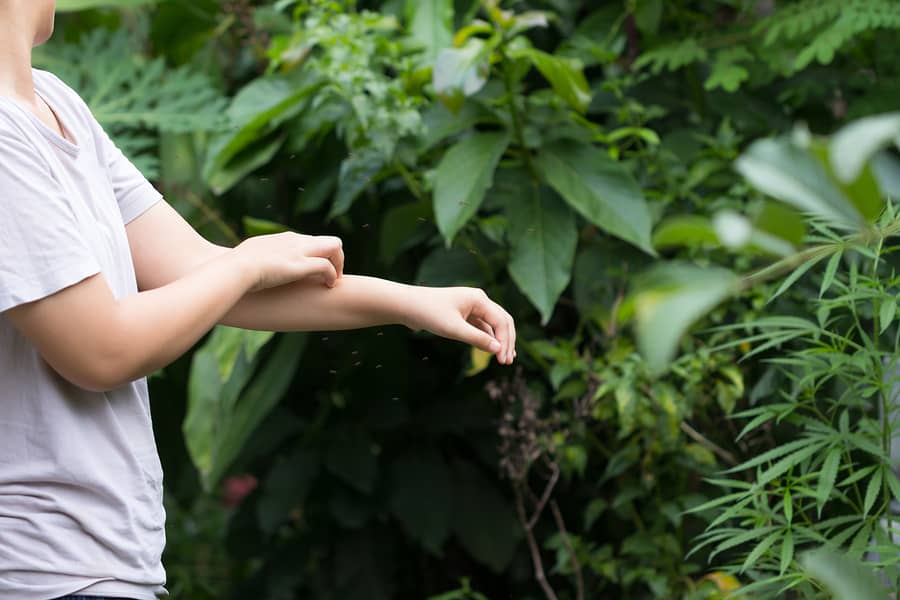
As the weather continues to pull you and your family towards more outdoor activities, the chances of getting bug bites increases. Here are some tips to prevent these bites and stings, and get back to enjoying your summer:
Treating bug bites and stings can put a damper on any outdoor activity. If you have issues with biting/stinging pests, call (866) 616-0862 or request a free pest inspection from your local pest control company.
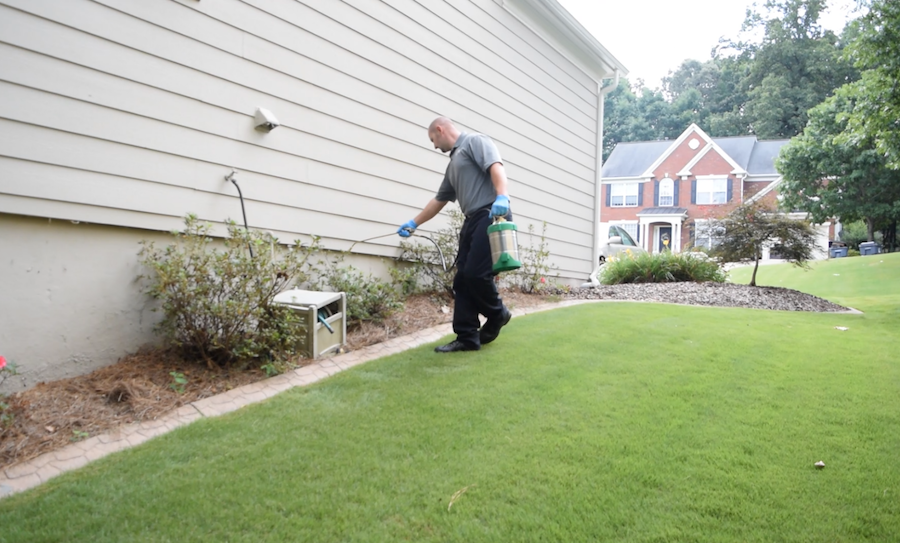
There are several methods of pest control out there from DIY pest control, to traditional pest control and green pest control from a professional exterminating company. No matter which method you choose, any pest control efforts are well worth the investment. Pest prevention is always the best first line strategy for pest control. Keeping your house clean and well-sealed, keeping your yard mowed, and practicing good hygiene in and around your home are all simple preventative measures that anyone can take. Pests can be tenacious, however, and sometimes these efforts just aren’t enough.
Pests can cause a multitude of problems for your home, property, and even your health. Some common household pests include termites, which can significantly damage or even destroy your home; cockroaches, whose droppings can spread disease and trigger allergies and asthma; mosquitoes, that can transmit diseases like West Nile virus and Zika virus; ants, which can cause painful bites and contaminate food; fleas and ticks, which not only cause painful, itchy bites but can also transmit serious diseases like Lyme disease and STARI; bed bugs, which can quickly infest your home and be quite costly to remove; and rodents, who can damage wood and wiring, as well as transmit serious diseases.
The National Pest Control Association estimates that Americans spent over $3 billion on pest control and extermination services last year. If you’ve ever had a pest problem in your home, most would agree that this investment in pest control is worth it. Here are the benefits to using a professional pest control company:
The health and safety of family and pets is at the top of the priority list for most people. Pests carry harmful diseases and bacteria that can expose your family and pets to illness. Eliminating these pests quickly can help minimize exposure and protect your family’s health and well-being in the long run. Many pest control companies now offer green pest control options that use products derived from flowers, plants, and natural earth elements rather than harsh chemicals.
Pest control professionals have the training, education, and expertise to handle many different types of pests. They know the safe and proper methods to identify, prevent, and eliminate each of these different pests, as well as where and how often to utilize them. They also have access to the most cutting edge technology and techniques in the field, as well as products and treatments that may not be readily available to consumers.
Pest control effectiveness is maximized by finding the source of the problem. If you have treatment without successfully eradicating the source, the problem will continue to recur in the future. Routine pest control includes a survey and pest control inspection inside and outside your home. This can not only help them identify the source of your current pest problem, but also identify any pest issues you may not know about yet or any issues that have the potential to become future problems. Based on their inspection, the pest control technician can provide you with a customized pest control program using the most innovative and advanced products and equipment, implementing Integrated Pest Management (IPM) techniques, that includes the inspection and plan, along with pest identification, ongoing perimeter protection, and continuous communication to help prevent problems in the future. Routine treatment and inspection also allows them to catch pest problems early before they have the chance to cause significant damage to your home and property.
While there may be a cost to you upfront, the cost savings in the long run can be significant for professional pest control services. Professional exterminating provides faster and more effective results than do-it-yourself methods, in most cases. They can also save you money in the future by identifying pest problems early and eliminating them fast, preventing a costly infestation and/or damage in the future. Most pest control companies also offer a service guarantee to come back between scheduled visits, if needed, at no additional cost to the consumer.
Ready to get started? Request a Free Pest Control Estimate Now.
The Dangers of Flea and Tick Bites
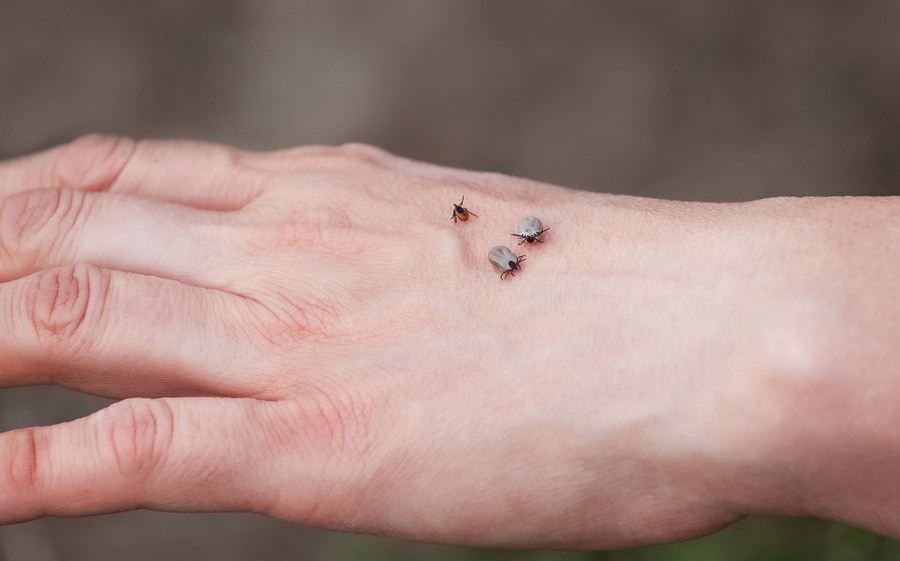
Nothing puts a stop to outdoor summer fun faster than an encounter with a tick or flea. A bite from either is irritating and sometimes painful, but they can also cause a host of issues down the road.
Bites from fleas are typically small, red bumps with a small halo that normally appear in a sequence of three to four. While pet owners are at a bigger risk of dealing with flea infestations, wandering wild animals or strays in your neighborhood can bring fleas in your yard causing a headache.
For humans, flea bites are very irritating, and the itch can lead to increased scratching. The excessive scratching can break the skin and cause secondary infections from bacteria. For your furry family members, flea bites can lead to severe dermatitis from a flea allergy, possible transmission of tapeworms, or anemia.
These bites can go away on their own; the use of calamine lotion can help with the itch. The best practice however is flea prevention. Fleas thrive in lawns with tall grass, so keeping lawns cut low and maintained will help with flea infestations. Also, regularly bathe and treat pets with preventative treatments year-round.
Ticks, like fleas, rely on tall grass to have access to hosts. They will position themselves at the very top of a blade of grass. Once a host brushes past, they will have the opportunity to bite and attach. Deer ticks, which are very common here in the South, fortunately do not always carry disease, and if they do, they would need to feed for up to 48 hours before a disease can be transmitted. This is why inspection of yourself and your family members after spending time outdoors is essential. Removal within 24 hours reduces your chances of being exposed to tick-borne illness, like Lyme disease.
When removing a tick, it is very important to remain calm. Pull back any hair from around where the tick is located. Find the head, and using tweezers, grasp the tick as close to the skin as possible. DO NOT grasp the body of the tick as this can squeeze the tick’s blood into the skin. Once you have a firm grasp on the head, pull in a straight motion, outward. Be sure to not twist when you pull as this can cause a tear, leaving the head to stay attached to the skin. Clean where the bite occurred and immediately flush the tick down the toilet or wrap tightly in tissue/paper towel and place in a trash can with a lid.
If you are going to be out in heavily wooded areas where the grass is unkept, wear long pants or high, light colored socks. Make sure to remove woodpiles from around your home as this makes a great hiding place for ticks. Using an insect repellant with DEET when outdoors is another great preventative measureto take against a possible tick encounter.
If you are having issues with fleas or ticks, contact your local pest control company or schedule a free inspection now.
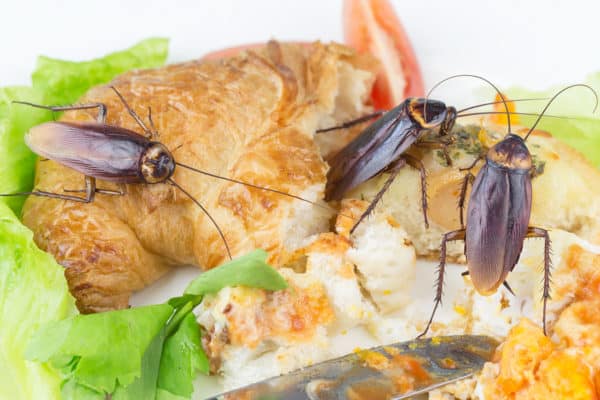
Cockroaches carry many diseases and can cause several health issues in humans including food poisoning and can trigger allergies and asthma attacks. So where do roaches come from?
If you have a roach infestation in your home, there could be several reasons why. Roaches may have already been in your home before you moved in. Roaches are also very good hitchhikers and are easily transported from one place to another. They can get into your home in grocery bags, cardboard boxes, luggage, furniture, or appliances. They can also get in through the plumbing, sewers or drains. They can travel over from your neighbor’s home into yours, too.
But what attracts cockroaches if your house is clean? Like most pests, roaches are looking for three main things: food, shelter, and water. They are year-round pests and are incredibly resilient – making them difficult to control. Different species of cockroaches are attracted to and thrive in different environments.
German cockroaches are the most common indoor roaches. They prefer dark, warm, humid places near food and water, preferably in a temperature range of 70 to 75 degrees Fahrenheit. You can usually find German roaches in kitchens, in cracks and crevices of cabinets, near sinks or appliances, and in food prep and storage areas. They can also be found in bathrooms when the roach infestation is heavy. Early detection and control of german roaches is extremely important as they can be very hard to get rid of.
Oriental roaches prefer dark, damp, cool habitats. Outdoors you can usually find them where there is an abundant supply of organic matter like mulch or wood chips, under patio bricks, or between the soil and your foundation. Once inside your home, they are often found in drains, basements, and crawlspaces. They can also be found near leaky water pipes, under sinks, refrigerators, floors, and washing machines.
Brown-banded roaches prefer warmer, drier places (greater than 80 degrees Fahrenheit). They live in higher areas, usually at eye level or above, like your cabinets, pantries, closet shelves, behind pictures, in books, or under kitchen tables and chairs. They can also be found in warm areas such as near clocks, timers, TVs, and refrigerator motors.
American cockroaches are found in homes, restaurants, bakeries, and grocery stores – anywhere food is prepped and stored. They prefer warm, moist environments and can often be found in boiler rooms, basements, around pipes and water heaters, and in drains and sewers.
Here are some tips to prevent roaches from infesting your home:
Clean up spilled crumbs and food immediately. Don’t leave dirty dishes out overnight. Throw away any food that is left out on the counter. Wipe down the surface of all food prep areas every night. Clean under your appliances and wipe down any that are on your counter. Make sure to clean underneath the refrigerator and stove, also. Rinse out milk jugs, juice cartons, and cans before throwing them away. Empty your garbage can every night and use garbage cans with tight fitting lids. Check kitchen drawers for any food debris and crumbs. Store food in airtight containers. Store pet food in airtight containers and elevate them off the floor. Don’t leave your pet’s food and water bowls out overnight. Roaches communicate through chemical pheromones they secrete as they move. Cardboard and paper are excellent absorbers of these pheromones. Replace cardboard boxes with plastic containers if possible. Don’t bring any cardboard boxes used for storage inside the home. Don’t store piles of newspapers – recycle them instead.
Carefully inspect the interior and exterior of your home. Seal any gaps or crevices you find, even the smallest ones. Roaches can squeeze through the tiniest openings to get into your home. Use weatherstripping around all entryways including doors and windows. Declutter as much as possible. Roaches can also get into your home through drainpipes. Use stoppers or metal baskets on all the drains in your sink and shower and make sure to keep your drains clean. Roaches will also hitch rides on firewood. Make sure to only bring in enough wood for one fire and don’t store any extra wood inside.
Most species of roaches prefer moist areas so eliminating water is key to helping prevent them. Remove any standing water in and around your home. Check for leaks and repair them promptly. Use caulk to seal gaps around your sink and tubs to keep water out of the walls. Don’t let water stand for long periods of time in plants and flowerbeds. Don’t leave your pet’s water bowls out overnight. Hang any wet towels and mats up to dry after using them. Keep your kitchen sponges dry and don’t store them on the counter.
Roaches can be incredibly difficult to control and eliminate. If you have a roach problem, contact a professional pest control company or schedule a free pest inspection now. A pest control technician can thoroughly inspect your home to identify not only where and how roaches are getting into your home, but also the specific type of roaches to better treat and eliminate them.
Why Are There so Many Millipedes in my House?
Is Your Hotel on the Bed Bug Registry?
Lawn Survival Tips for the Summer Heat
What Attracts Cockroaches to a Clean House?
Is Termite Protection Worth It?

Millipedes, also known as “thousand leggers,” are arthropods that often make their way into our homes. Millipedes range from 2.5 to 4 cm long, are brownish in color, are long and slender, and look a lot like worms with legs. They are segmented with 2 pairs of legs per segment. Millipedes are nocturnal and tend to move in large numbers. They are also scavengers, feeding on decaying plant material in and around your home. While they are definitely creepy looking, they don’t bite or cause any damage to your home or food supplies.
Millipedes are often found outdoors in damp places such as mulch, flowerbeds, under leaves, compost, rotting wood, and under stones in your yard. They are also commonly found around foundations. Excess rain, drought, and cooler temperatures can make their outdoor habitats less favorable for them and you will often see millipedes in the house during these conditions. Excess rain will drive them indoors in search of shelter and drought will drive them indoors in search of water. Once in your home, they tend to gravitate toward damp areas such as laundry rooms, basements, and crawlspaces. Millipedes will usually die fairly quickly once they get inside due to the lack of moisture. If you’re wondering how to get rid of millipedes indoors, you can simply remove them with a vacuum cleaner or shop-vac.
How can you prevent a millipede infestation from taking over your home? Here are a few tips to prevent millipedes in the house.
What to Expect When Signing Up for Termite Protection
Lawn Care: What’s Causing Yellow Spots on Your Lawn & How to Fix It

Just as the weather changes with the seasons, pest activity shifts to usher in new groups of active pests. Let’s take a look at what pests are active in your area and some tips to keep them away.
The humidity and moisture that come with early summer is what helps to increase subterranean termite activity. “Swarm season” is in full effect, and this can present a problem for your home.
Summer is the biggest travel time for many. College students are coming back home, and family vacations are planned. This increases the chances of having an incident with bed bugs, and a bed bug infestation is no easy battle.
As the summer weather starts to rev up, American cockroach activity will skyrocket. While they live outdoors, if they find themselves low on food or if the weather experiences a drastic change (extreme heat or excessive rain), they will try move indoors.
Pest infestation can be costly and a major hassle. Contact a professional pest control company like Northwest for a free pest control estimate to protect your home from pests year-round.

As a business owner or manager with a commercial property, you’ll most likely be faced with a pest issue during the duration of operating your business. And while pest control service may be optional for homeowners, it’s often a necessity or requirement for businesses, especially those where food preparation, distribution, or storage is involved, or any facility that offers a storefront or location for customers to visit. The appearance and condition of your commercial property is often your customer’s first impression of the business, so it’s critical that pests are not an issue or seen by existing and potential customers, or even employees!
Because of the health risks and threats pests can present, it’s essential to take a proactive approach to commercial pest control. This includes regular pest inspections by an exterminating company that specializes in pest control for businesses and routine, often monthly or quarterly, pest control treatments. So what are your options when it comes to commercial pest control and what can you expect from the initial call to an exterminator to service and follow ups? Here’s what you need to know:
The first step in any pest control plan, commercial or residential, is to identify past, current or potential pest threats. Businesses commonly experience issues with roaches, rodents, termites and mosquitoes – but may also experience wildlife invasions (squirrels, raccoons, birds, bees, snakes, and more) and other minor pests issues.
Because of the sanitation conditions associated with roaches, rodents and wildlife, treatment and prevention is key. Your exterminator will inspect the entire property to identify entry points and areas of infestation, and provide prevention recommendations for clean-up and a pest control plan for monthly or quarterly treatments, depending on the severity of the pest issue.
Mosquitoes also pose health risks by spreading diseases like zika, West Nile, Encephalitis, and dog heart worm and causing mosquito bite allergies. If your business serves customers outdoors, you should have your property inspected for current and potential mosquito resting and breeding sites, eliminate or reduce these areas, and request monthly mosquito treatments during peak mosquito season, usually April through October. Mosquito control service is the best way to prevent mosquito bites and minimize risk of mosquito-borne diseases.
Wildlife invasions are also common and can present damage and sanitation issues for business owners. If you suspect a wildlife issue, contact a wildlife control company immediately to inspect the property, identify wildlife issue, and offer solutions for wildlife exclusion and prevention.
Once you have your property inspected, pest issues identified, and you have treatment and prevention options, review proposals and determine the best fit for your business. If you’re looking for eco-friendly options that are effective yet utilize non-toxic products and careful application, consider an exterminating company that specializes in green pest control.
Other factors to consider when choosing an exterminator for your business:
Have more questions about commercial pest control? Call us now or request a free estimate to get started.